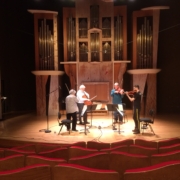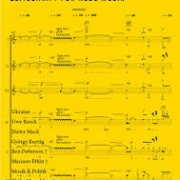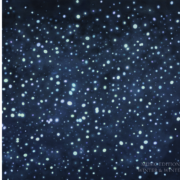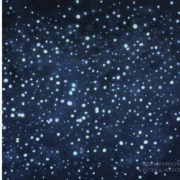invisible threads
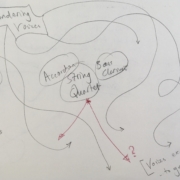
“Invisible Threads heißt das neue Werk des Briten Christian Mason, das beim Stuttgarter Festival Eclat das Arditti Quartet aufführte. Unsichtbare Fäden verknüpfen sich in der Performance Installation mit Texten von Paul Griffiths.
Kann Klang die Gesellschaft verändern? Glaubt man dem britischen Komponisten, Musikkritiker und Autor Christian Mason, dann ja. Gerne spricht der 40-Jährige darüber, wie Klänge die Zeiterfahrung verändern können – bei Musikerinnen und Musikern ebenso wie bei den Lauschenden. Beim Stuttgarter Neue-Musik-Festival Eclat ist Masons Stück „Invisible Threads“ jetzt aber auch so etwas wie eine Utopie gewesen: die (wie man heute gerne schick sagt: „immersive“) Erfahrung einer verbundenen Gesellschaft.
Diese Gemeinschaftserfahrung hat etwas von einem Gottesdienst. Die Veranstalter des Festivals von Musik der Jahrhunderte haben die große Halle T 1 des Theaterhauses während des gesamten verlängerten Wochenendes leergeräumt, um neue Raum-Erfahrungen möglich zu machen. Beim Rundgang der Schlagzeugerin Vanessa Parker am Eröffnungstag hat das noch keine neuen Perspektiven eröffnet. Wohl aber jetzt. Der Saal wirkt tatsächlich wie eine Kathedrale der Klänge. Sängerinnen und Sänger der Neuen Vocalsolisten sorgen mit Mundharmonikatönen schon im Foyer für ein Gegenstück zum kirchlichen Orgelspiel geleiten, das einen hinein geleitet in ein ritualisiertes Schreiten und Tönen.
Die Anfangstöne kann man erst kaum orten. Kommen sie von der Empore oder aus den Fluren hinter den geöffneten Türen? Die Neuen Vocalsolisten (wunderbar sauber intonierend!), die Streicher des Arditti Quartets (das nach dem Konzert auf sein 50-jähriges Bestehen anstößt), der Bassklarinettist Gareth Davis und der Akkordeonist Krassimir Sterev lassen sich erst hier nieder, dann dort, bilden Inseln des Klangs, spielen kleine Tonfolgen oder Intervalle, geben sie weiter, nehmen auf, was andere singen oder spielen, finden dann wieder in neuen Konstellationen zusammen.
Zu hören ist eine sehr eigene Art von Post-Minimalismus – ein feiner, sehr schöner, mäandernder Klangstrom aus Wiederholungen und subtilen Veränderungen. Er bleibt im Rahmen des Tonalen, es gibt viele Quinten. Die Klänge verändern sich im Raum, deshalb trägt das Stück den Untertitel „Performance Installation“ und will vom Publikum nicht nur mit den Ohren, sondern auch mit den Füßen erobert werden. Das hat einen eigenen Sog. Wer sich einlässt auf die faszinierende Verschmelzung von Zeit und Raum, spürt nichts mehr vom Vergehen der Zeit. Man lächelt sich an, wenn man aneinander vorübergeht. 70 Minuten? Das kann doch nicht wahr sein.”

“Invisible Threads is the name of the new work by the British Christian Mason, on texts by Paul Griffiths, which the Arditti Quartet played at the Stuttgart Eclat Festival, in a performance installation.
Can sound change society? If you believe the British composer, music critic and author Christian Mason, then yes. The 40-year-old likes to talk about how sounds can change the experience of time – for musicians as well as those who listen. At the Stuttgart new music festival Eclat, Mason’s piece “Invisible Threads” was something of a utopia: the (as we like to say today: “immersive”) experience of a connected society.
This community experience is something like a church service. The organizers of the Festival – Musik der Jahrhunderte – cleared out the large hall T 1 of the theater during the entire long weekend in order to make new spatial experiences possible. During drummer Vanessa Parker’s tour on opening day, this didn’t open up any new perspectives. But now. The hall actually seems like a cathedral of sounds. Singers from the Neue Vocalsolisten provide a counterpart to church organ playing with harmonica tones in the foyer, which leads you into a ritualized walking and toning.
The initial tones can hardly be located at first. Are they coming from the gallery or from the corridors behind the open doors? The Neue Vocalsolisten (with wonderfully clean intonation!), the strings of the Arditti Quartet (which celebrates its 50th anniversary after the concert), the bass clarinetist Gareth Davis and the accordionist Krassimir Sterev settle first here, then there, forming islands of the Sounds, play small sequences of notes or intervals, pass them on, record what others sing or play, then come together again in new constellations.
You can hear a very unique kind of post-minimalism – a fine, very beautiful, meandering sound stream made of repetitions and subtle changes. It stays within the tonal framework, there are many fifths. The sounds change in the room, which is why the piece is subtitled “Performance Installation” and wants to be conquered by the audience not only with their ears, but also with their feet. This has its own pull. Anyone who gets involved in the fascinating fusion of time and space no longer feels the passing of time. You smile at each other when you pass each other. 70 minutes? That can not be true.”
Somewhere in the Distance (Lost in the Horizon)
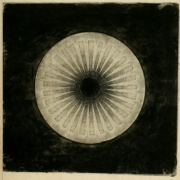
“Somewhere in the Distance (Lost in the Horizon) by Christian Mason will surely also fascinate a Philharmonic audience with its finesse in spatial sound and its film music echoes of psychological thrillers, who mainly listen to Bruckner, Ravel, and Sibelius.”
Songbooks Vol. 1
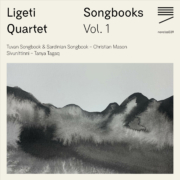
“Mason’s Songbooks for string quartet, arrangements of songs from Mongolia and Sardinia, need not be shamefaced in this company. The source material, whether Asian or Mediterranean, makes much of overtones, encouraging Mason to skid off on more explorations of natural tuning. Rhythmic excitement, too, is rampant. And there is distance – not only in how the music arcs across the globe but also in the increasing separation of the players as they go from one Sardinian song (recordings by the Tenores di Bitti provided the models) to the next. The Ligeti Quartet swing into everything with high-precision vim, not least – but certainly not only – when given the chance to take part vocally.“

“Mason has also explored the very different musical consequences of making and sharing sounds that represent potentially harmonious relationships between nature and humanity. His two sets of Songbooks for string quartet, in magnificently vivid performances by the Ligeti Quartet, offer boldly sculpted interpretations of vocal music – by Tuvan throat singers and the Sardinian ‘tenores di Bitti’ – that replace the troubling mysteries of outer space with the earthy embrace of vibrant communal celebration. As Mason writes in the booklet notes, these musics seem ‘pure and rough’ at the same time, and his rethinkings acknowledge such polarities, yet the predominant characteristic – unmistakable in these high-powered, closely focused recordings – is sheer, unadulterated exuberance.”

“Mason’s insight into these traditions, as well as his deep knowledge of Western classical string techniques, has given rise to a remarkable exploration of these sounds in string quartet form. Doing more than merely transcribing existing repertoire from within the two traditions, the ten pieces mimic vocal overtones by employing certain extended string techniques that could be said to be their string equivalents… [The] quartet’s virtuosic interpretations of Mason’s experiments are quite unique and worth a listen for classical aficionados and connoisseurs of overtone singing alike.”

“Mason’s music is astonishingly inventive and powerful, generating a searing, hypnotic intensity among the four-piece Sardinian Songbook and its sudden eruptions of euphoric noise. The Ligeti players deliver remarkably committed, focused performances, thrillingly responsive to the subtle fluctuations in tone and attack needed to bring this music alive…It’s a potent, persuasive disc, delivered in a close, authentic recording.”

“This CD demonstrates how overtones can be exploited on stringed instruments. Mason’s Tuvan Songbook is based on four numbers recorded in Central Asia, each propulsive dance making reference to the importance of the horse in Tuvan culture. Mason brilliantly assimilates the various ingredients: the quartet’s players reproduce the folk dance of “Kuda Yry”, singing along at several points. And then, a few minutes in, we’re treated to a startling, eerie display of harmonics and overtones. It’s enchanting, and these players never sound as if they’re going through the motions; the sense of intent is a constant.
The Sardinian Songbook is earthier, prompted by Mason’s discovery of the Tenores di Bitti as a student. These four numbers are earthier, and as with the Tuvan songs, it’s the moments where the overtones emerge which really take flight, as in the “Ballate a Ballu Tundu”. Listen carefully and you can hear the musicians standing further apart from each other as the work progresses, the sound becoming lighter and airier. Wonderful… You’ll be hooked, I promise, and a second volume is in preparation.”
This present moment used to be the unimaginable future…
Eternity in an hour
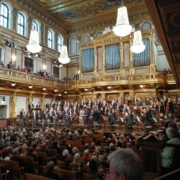
“Eternity in a hour lautet das Orchesterwerk des zeitgenössischen Komponisten Christian Mason, dessen Werk unter keinem Geringeren als „Kapellmeister” – Maestro will er nicht genannt werden – Christian Thielemann, 60, und den Wiener Philharmonikern im Musikverein Wien erst zum zweiten Mal vor Publikum präsentiert wird.
Ein psychedelisch anmutender Flug durch Raum und Zeit, der getränkt ist von obertonreichen Klängen, deren Ursprungsinstrumente nicht immer sofort deklariert werden können. Von Didgeridoos, Maultrommeln und verzehrten E-Gitarren-Riffs bis hin zu kreischenden Violinen reichen die Assoziationen, die von dieser schrägen Klangkulisse hervorgerufen werden. Beinahe wähnt man sich aufgrund der Deckenventilatoren, die immer mehr an Helikopter-Propeller erinnern, schon im Saigon der 1970er Jahre, hin– und hergerissen zwischen Opiumhöhle und Schlachtfeld, wäre da nicht die Pause, die der intensiven aber kurzen Reise ein abruptes Ende setzt.”

“Eternity in an hour is the orchestral work of the contemporary composer Christian Mason, whose work was performed in front of an audience for only the second time by none other than “Kapellmeister” – he does not want to be called a maestro – Christian Thielemann, 60, and the Vienna Philharmonic Orchestra at the Musikverein Wien.
A psychedelic-seeming flight through space and time that is soaked in overtone-rich sounds whose original instruments cannot always be immediately explained. The associations evoked by this strange soundscape range from didgeridoos, Jew’s harps and wasted electric guitar riffs to screaming violins. The ceiling fans, which increasingly resemble helicopter propellers, almost make you think you’re in Saigon in the 1970s, torn between the opium den and the battlefield, if it weren’t for the break that brings the intense but short journey to an abrupt end.“
Zwischen den Sternen
Layers of Love
Man Made

“…David Harsent (of much musical collaboration, particularly with Harrison Birtwistle) read with dignity his three poems – Ocean, Rainforest, Icefield – that Mason has set in Man Made. Anu Komsi is no stranger to cutting-edge music, or to negotiating high notes, and there are plenty in the twenty-minute Man Made, going beyond those in Berg’s Lulu to join the stratospheric demands found in Adès’s Exterminating Angel. She navigated them with aplomb; more than that she performed with poise and expression in writing of craggy stillness that initially reminded of Peter Maxwell Davies’s Stone Litany. The scoring includes ten strings, alto flute, contrabass clarinet and rather a lot of percussion, deftly handled by the athletic Stephen Burke, in these continuous settings that slowly evolve and include a tumultuous and clangourous acceleration that really accentuated that this is music of great import. Gergely Madaras conducted both works with unflappable dedication, played with equal distinction.”
Aimless Wonder

“(…) After the interval, Christian Mason sounded all kinds of nature sounds with two horns and a string trio, which was partly playing in the foyer, as if the far post horn out of an Eichendorff poem was regarded in a distorting mirror. The jerkiness of the entering and leaving musicians was a bit contrary to the calm of the music. (…)”

“(…) Christian Mason’s “Aimless Wonders” completed Ligeti with a subtle, timeless, in itself circulating and tonally fastened happening. Even from the outside one could hear the horns at the beginning together with the solo violin. At the end all string players, including the solo violin and solo alto, leave the stage, except from the cellos, the double basses and the horns. The musicians continuing to play from afar created another beautiful effect.”
Unseen Light

“This music is delicate, initially nearly tender, self-aware, shimmering, yet never boastful. …The young winner of the Composers‘ prize of the Ernst von Siemens Music Foundation stands for finest listening experiences. Rarely has the music of a young composer managed to radiate such magic”
Open to Infinity: a Grain of Sand

“The pacing of the work and the drawing out of the arc of its argument is masterly and compelling”

“…its gradual yet intensive build-up towards a regaining of initial momentum that was conveyed with no mean resourcefulness and abetted by a palpable rhythmic focus.”

“…as concentrated in sound as its inspiration from William Blake will have demanded.”

“…crystalline concision and expressive precision…”
The Years of Light

“The overall sonic mood is static, shimmering textures regarded for a block of time. But the textures are often lovely, especially at the end: Over a breeze of strings, the harmonicas, gently chirping, processed out of the hall and onto the Tanglewood lawn, a marvelously charming effect.”

“… the most immediately appealing piece on the program was the one that seemed least likely to succeed, Christian Mason’s “The Years of Light,” a TMC commission and world premiere. The English composer, a Bob Dylan fan, begins with a Dylan premise: 12 harmonica players lined up in a semi-circle behind the instrumental ensemble. (They later make a recessional from the stage.) The title is taken from a poem by David Gascoyne, which isn’t sung. Instead, a soprano and mezzo-soprano, each paired sonorously with solo instruments, vocalize as if from afar. What might be silly or pretentious turns out to be music slowly oscillating and shimmering, like sounds from deep space.”
Racing Horses

“The young composer Christian Mason, whose witty, gleaming arrangement of Huang Hai-Huai’s Racing Horses galloped home in five minutes flat, must be just the sort of musical successor that Jonathan Harvey would have hoped for.”
Learning Self-Modulation

“[Learning Self-Modulation] represents the sum of a thorough research in sound, in which the players are asked to hum and pluck the piano strings… Through this music the interpreters take the opportunity to construct a universe of sensations and invite the spirits of the listeners to wander. And if certain moments appear tense or tempestuous, both musicians complete their interpretation on floating notes, suggesting a voyage in some wild country, mythical or dreamt.”

“This week, an unusual violin tuning and the world’s oldest orchestra made for thrilling listening… The British premiere of a piece called Learning Self-Modulation, by Christian Mason (b1984), required both pianist and violinist additionally to hum, the pianist to play pizzicato and the violinist to retune her strings as she went along, before taking up a second instrument fitted with four variously tuned G-strings. There was a sort of new-age relish to this extremism, but a solid craft in evidence, too.”
In Time Entwined, In Space Enlaced

“Over the past four decades the London Sinfonietta has had an enviable record in identifying and nurturing new talent, so although it’s impossible to predict whether the likes of James Olsen and Christian Mason will ultimately make the sustained impact of a Tavener or a Birtwistle, the Sinfonietta’s seal of approval gives them the best possible start. Mason (b1984) is the youngest, and his In Time Entwined, In Space Enlaced belies its cumbersome title to offer a bracing exploration of a sound world which is sometimes brittle, sometimes lyrical. The spatial distribution of the players and ‘the ethereal sound of 36 handkerchief-harmonicas, placed throughout the audience’ go for less on disc than they do in the hall but the piece manages to be something more than the sum of its influences.”

“[Discs 5 and 6] are the last and best in London Sinfonietta’s Jerwood Series, which offers snapshots of young composers who otherwise might struggle to have their work properly recorded. Highlights? … On the 6 disc, it’s a toss-up between Christian Mason’s elusive In Time Entwined, In Space Enlaced and Kenneth Hesketh’s Detail from the Record, a birthday bouquet to conductor Oliver Knussen.”

“Christian Mason’s In Time Entwined, In Space Enlaced is scored for small ensemble, in fact three trios – each consisting of one woodwind, one percussion and one string player. The music sounds somewhat more modern but never extravagantly so, and the composer’s fine ear for arresting sonorities is quite often brilliantly and tellingly displayed. It seems that “the ethereal sound of thirty-six handkerchief-harmonicas, placed throughout the audience” should be heard occasionally, but the recording does not make this quite obvious. This is a very minor reservation about an otherwise highly inventive score written for the ensemble’s fortieth anniversary.”

“The most engaging was Christian Mason’s In Time Entwined, In Space Enlaced, in which the otherworldly sounds of the spheres echoed around the auditorium.”

“Christian Mason’s In Time Entwined, In Space Enlaced used spatial elements to beautifully imagined effect”
Noctilucence

“The very first sounds of the afternoon’s premiere – Noctilucence by the young British composer Christian Mason -opened a door to a very different world, gentle and subtly coloured in a way the title might lead you to expect (noctilucent clouds are those rarely seen ones that glimmer high up at dusk). Then the music seemed to turn against itself, becoming sharp-edged and fierce, though the earlier mood somehow persisted alongside. It was intriguingly ambiguous in a way that made me want to hear it again, immediately.”

“It says much for the 25-year-old Christian Mason that his new piece, Noctilucence, didn’t suffer from comparison. He draws his title and inspiration from a mysterious cloud that hovers far above where clouds ought to be, and hence shimmers in sunlight on summer nights. That is exactly what his piece conveys. The first half is audaciously hushed – very few notes, very slow, and lots of silence suggesting the Universe beyond the clouds. Then an ecstatic dance erupts, full of rude vigour, rushing scales and shuddering rhythms. Rarely can the cliché ‘Every cloud has a silver lining’ have been better conveyed. A work of high imagination, in every sense. Catch this fascinating programme in Birmingham Town Hall today or Norwich Assembly House tomorrow.”

“The concert has been programmed by John Woolrich, and it consists of short Birtwistle pieces interspersed with his arrangements of Bach’s Art of Fugue, and bookended by his arrangements of works by the medieval composer Machaut and the Renaissance composer Ockeghem. Popped in among all this – by no means outclassed by the heavyweight music with which it is intimidatingly surrounded – is an exquisite new piece by young composer Christian Mason called Noctilucence.”
Clear Night

“The latest (the seventeenth) of the UBS commissions proved energised and bracing, craggy and brilliant, the title of Clear Night (from David Gascoigne’s poem ‘Tenebrae’) vividly suggested in the music, the score itself being tightly organised and imaginatively orchestrated, compelling over its seven minutes and suggesting that Christian Mason (born 1984) is a composer to watch out for.”

“Instead of the consoling intimacy that opens Beethoven’s Fourth Piano Concerto the concert started by plunging into the glittering vortex of Christian Mason’s Clear Night. Occasional flashes of Berg and Bartok, and quite a lot of Messiaen, light up the shimmering orchestral colours, though Mason mostly manages to forge them into a sound-world of his own. At five minutes the piece did not outstay its welcome. The challenge will be whether Mason can make his ideas work as consistently for longer.”

“Christian Mason’s Clear Night! came across as the most experimental of the three works. It is complex in texture and technique, and is cast in a single span. It uses many unusual musical effects, including deliberately wide vibrato and slow glissandos from strings and woodwinds, as well as sudden accents cutting across the texture. Mason noted that he was trying to convey something of the exhilaration of the clear night sky, punctuated by points of light from bright stars. The dense textures made this perhaps the hardest work to grasp, but maybe also the one which would repay the most from additional hearings.”
Under Heaven: sometimes…

“Christian Mason succeded well in Under Heaven: sometimes…, elucidating relationships and connections between the instruments which formed his rich tapestry.”
Aspects of Radiance

“The scores came from a wide spectrum of ages… with a young York University student, Christian Mason, only just emerging from his teenage years, providing a shimmering Aspects of Radiance.”

“Christian Mason’s Aspects of Radiance had a timeless translucence, slithering bluesily towards gentle disintegration. A young talent, and one to watch.”

